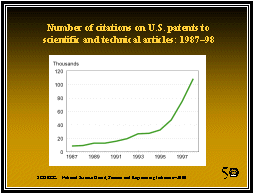 |
|
|
 |
||
|
||||||||||
Linkages Grow Between Research and InnovationJune 2000
Record Numbers Seen in New Patents and Citations to Research. The 1990s saw the end of the Cold War, the beginning of the Internet and a major shift in the focus of the economy within the U.S. and overseas. A dramatic indicator of this shift was the sudden increase in new patenting activity. New patents were awarded in record numbers. According to Science and Engineering Indicators 2000, the U.S. awarded 148,000 patents in 1998, a meteoric rise of 32 percent in just one year over 1997 totals. The percentage increase was as large for foreign inventors as it was for U.S. inventors. Just as impressive was the growth in citations to U.S. research articles for patents awarded over a recent two-year period. At the end of 1996, there were 47,000 such citations for the year. In 1998, they jumped to 108,000, more than doubling the total of two years' previous. In the field of biomedical research alone, scientific articles cited in patents went from just below 20,650 per year to nearly 55,900 per year from 1996 to 1998. Two possible reasons for the steep increase in patenting and the rise in patent citations to scientific literature include: (1) a growing closeness of some research areas to practical application; and (2) the U.S. Patent and Trademark Office's (PTO) increased willingness to award "upstream" patents, more often associated with pre-development work or "building blocks" resulting from research. New patent citations to "prior art" (that which contributes materially to the product or process being patented) increasingly include scientific and technical articles. This trend is considered a strong indication of the increased link between research and innovative application, as inventors and entrepreneurs develop new processes and products built upon basic and applied research, often from publicly funded sources. Academic patenting is on the rise. Universities are "giving increased attention to potential economic benefits inherent in even their most basic research…especially in the life sciences," says the new edition of Science and Engineering Indicators, 2000. In doing so, universities are moving to protect the results of their work. The number of universities receiving patents grew rapidly in the 1980s and has slowed down somewhat in the 1990s. Conversely, the top 100 public and top 100 private universities have increased their patenting activity tremendously since 1995. Academic patents have risen at a much higher rate than for all U.S. patents on an annual basis since the 1980s. Unlike industry, however, academic patents have concentrated in a much smaller range of study areas. Universities, while moving to protect their research, have also shown a willingness to exploit its economic potential through royalties and licensing arrangements with industry. Companies and entrepreneurs are recognizing the importance of research and are investing in its market potential. In 1997 and 1998, a rapid rate of increase not only occurred in the numbers of academic patents and patent applications, but also in license disclosures, revenue-generating licenses and options, and new startup firms. Ethical questions are not only scientific but business-related. Rising university patenting activity and collaborations with industry have raised questions about "possible unintended consequences." Concerns are many and varied, among which are: potential distortion of the nature and direction of academic basic research; contract clauses specifying delays or limitations in the publication of research results or suppression of results for commercial gain; the potential for faculty members' conflicting economic interests or arrangements; universities' potentially ambiguous position as they acquire equity interests in commercial enterprises; and finally, whether or not the patenting of government-sponsored research results is detrimental to the goal of enhancing the transfer of new technologies. Conclusion. Despite the more troubling questions that dot the landscape, the collaborative efforts within science and engineering are growing among universities and their researchers, and within disciplines - also among international partners and government/private/nonprofit entities. All point to increasing economic benefits from the relationships. And as links grow among physical, life and social sciences, new issues come into sharp focus, including how to incorporate societal benefits from research, and potential negative consequences to be avoided. For more information, see: Chapters 6 & 7, Science & Engineering Indicators, 2000
|
||||||||||
|
|
||||||||||
|
|
